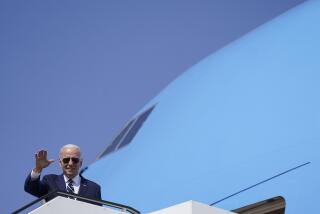Singapore Proves a Welcome Friend for U.S. Military : Southeast Asia: Bush’s visit will be a gesture of gratitude for its willingness to accept warships, planes.
- Share via
SINGAPORE — When President Bush arrives in Singapore tonight, his visit--the first by a U.S. President--will represent a gesture of American gratitude to this tiny nation for opening its arms to U.S. warships and airplanes at a time when virtually no one else in the region wants them.
The Philippines only recently told the United States to withdraw the last of its naval forces from Subic Bay Naval Base within a year, marking the end of nearly a century of U.S. military presence in the country. Malaysia and Indonesia have both spoken against the idea of U.S. military facilities in Southeast Asian nations, once the Philippines is rid of them.
But Singapore, one of the most politically conservative Southeast Asian nations, has actively campaigned for the United States to remain militarily involved in the region and has expressed fears about resurgent Japanese military power.
“The American presence, in my view, is essential for the continuation of international law and order in East Asia,” said Lee Kuan Yew, the former Singapore prime minister who now holds the title of senior minister in the government.
“We’d all be happier,” he said in a published interview, “if the American security alliance remains, leaving Japan to concentrate on high-definition television.”
Indeed, Singapore is so committed to keeping an American presence that it plans to intensify its dealings with Washington, allowing even greater access to its naval and air facilities--the use of the word bases is politically taboo--to visiting U.S. forces.
In Washington, officials said that a deal to move Command Task Force 73, a naval command post, from the Philippines to Singapore “is in the works” and may be ready for formal announcement during the President’s visit. The agreement would bring 130 or so more U.S. naval personnel--and about as many U.S. military dependents--to Singapore.
Pentagon officials also confirmed that Singapore is to become a key area for ship repair facilities lost with the closure of Subic Bay. Existing Singapore facilities, such as the Sembawang Port and the Paya Lebar Airport, are to be modified slightly to accommodate the expanded U.S. presence, American officials said. Under earlier agreements to expand the American military’s reliance on Singapore, the U.S. Air Force and Navy will increase their troop presence in Singapore by 75 apiece.
These proposals would expand an agreement that the Singaporeans struck with Washington last year. That accord allows the United States to operate resupply vessels from Singapore and to carry out repairs at Singapore’s commercial shipyards. There were 70 such visits in 1991, with some stops by task forces of dozens of warships. Singapore became one of two “regional contracting centers.” The other is in Naples, Italy.
The agreement also allows the United States to rotate squadrons of Air Force F-15 and F-16 fighters into a Singapore air base for a month at a time from Japan, South Korea and Alaska.
The pact provides for visits, but there are about 30 permanent American naval staff and 35 air force staff now in Singapore.
Those numbers are far below the American level in the Philippines, where the Subic Bay base is to be vacated by the end of 1992 and Clark Air Base was forced to close last year because of a volcanic eruption. But the collapse of the Soviet Union and reduced defense spending have altered American strategic thinking in Asia.
“The naval brass is a lot more relaxed about the demise of Subic than they were a couple of years ago,” said one Western diplomat here. “Before, most U.S. military people were talking about how essential Subic facilities were. But now they are adjusting to the new post-Cold War strategy, which doesn’t envision a lot of bases but access to facilities a la Singapore.”
Singaporeans, the diplomat said, go even beyond what most American officials would dare to say, suggesting that the U.S. policy of containment worked in Vietnam. While Hanoi eventually triumphed, they argued, the American goal of keeping other nations in the region from communism was achieved.
Apart from commercial port fees, Singapore is not receiving any financial remuneration from the United States for providing access to its facilities.
But as one diplomat explained, the U.S. security blanket--implicit but not publicly stated--is a comfort to this nation of 3 million, sandwiched between the two Muslim nations of Malaysia and Indonesia. They officially are friendly but occasionally are hostile.
Singapore officials were deeply shocked by Iraq’s attempt to swallow tiny Kuwait in 1990, and often draw parallels between Kuwait and their own successful economy. Indeed, Singapore gave the Americans permission to use Singapore as a way station for aircraft traveling from the United States and Asia during the Gulf War.
Singapore keeps legal title and control to its facilities under the new arrangement, in which the United States must seek permission for each visit. But the authority is automatically granted.
Even the possible stumbling block of extraterritorial rights for visiting American military personnel has been neatly sidestepped. Although Singapore insisted on having legal authority over possible lawbreakers, since the agreement was signed last year it has turned over all U.S. service personnel who break the law to U.S. authorities for trial in American military courts.
After the Gulf War last year, U.S. naval authorities asked crews to vote on where they wanted to take their rest and recreation. They voted almost unanimously for Pattaya, the sun-and-sex resort in southern Thailand.
“It’s not the preferred R & R location,” sighed one Western diplomat about Singapore.
Times staff writer Melissa Healy in Washington contributed to this report.
More to Read
Sign up for Essential California
The most important California stories and recommendations in your inbox every morning.
You may occasionally receive promotional content from the Los Angeles Times.













